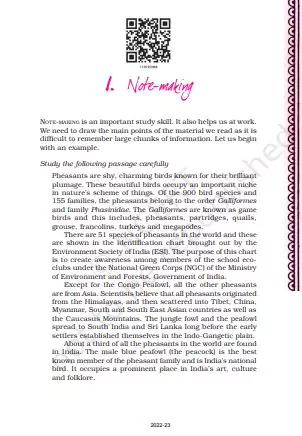‘NCERT Solutions for Class 11 English Chapter 1 Note-making‘ PDF Quick download link is given at the bottom of this article. You can see the PDF demo, size of the PDF, page numbers, and direct download Free PDF of ‘Ncert Class 11 English Chapter 1 Exercise Solution’ using the download button.
Note-making Book PDF Free Download

Chapter 1: Note-making
NOTE-MAKING is an important study skill. It also helps us at work. We need to draw the main points of the material we read as it is difficult to remember large chunks of information. Let us begin with an example. Study the following passage carefully Pheasants are shy, charming birds known for their brilliant plumage.
These beautiful birds occupy an important niche in nature’s scheme of things. Of the 900 bird species and 155 families, the pheasants belong to the order Galliformes and family Phasinidae. The Galliformes are known as game birds and this includes, pheasants, partridges, quails, grouse, francolins, turkeys and megapodes.
There are 51 species of pheasants in the world and these are shown in the identification chart brought out by the Environment Society of India (ESI). The purpose of this chart is to create awareness among members of the school ecoclubs under the National Green Corps (NGC) of the Ministry of Environment and Forests, Government of India. Except for the Congo Peafowl, all the other pheasants are from Asia.
Scientists believe that all pheasants originated from the Himalayas, and then scattered into Tibet, China, Myanmar, South and South East Asian countries as well as the Caucasus Mountains. The jungle fowl and the peafowl spread to South India and Sri Lanka long before the early settlers established themselves in the Indo-Gangetic plain.
About a third of all the pheasants in the world are found in India. The male blue peafowl (the peacock) is the best known member of the pheasant family and is India’s national bird. It occupies a prominent place in India’s art, culture and folklore.
STEP 1
Notice that the important information has been underlined.
Pheasants are shy, charming birds known for their brilliant
plumage. These beautiful birds occupy an important niche
in nature’s scheme of things. Of the 900 bird species and
155 families, the pheasants belong to the order Galliformes
and family Phasinidae. The Galliformes are known as game
birds and this includes, pheasants, partridges, quails, grouse,
francolins, turkeys and megapodes.
There are 51 species of pheasants in the world and these
are shown in the identification chart brought out by the
Environment Society of India (ESI). The purpose of this chart
is to create awareness among members of the school ecoclubs under the National Green Corps (NGC) of the Ministry
of Environment and Forests, Government of India.
Except for the Congo Peafowl, all the other pheasants
are from Asia. Scientists believe that all pheasants originated
from the Himalayas, and then scattered into Tibet, China,
Myanmar, South and South East Asian countries as well as
the Caucasus Mountains. The jungle fowl and the peafowl
spread to South India and Sri Lanka long before the early
settlers established themselves in the Indo-Gangetic plain.
About a third of all the pheasants in the world are found
in India. The male blue peafowl (the peacock) is the best
known member of the pheasant family and is India’s national
bird. It occupies a prominent place in India’s art, culture
and folklore.
STEP 2
Read the passage again asking yourself questions and answering
them as you read.
What is the passage about? — Pheasants
Where found? — Asia; particularly India (1/3 of total population)
Origin? — Himalayas
Time? — Long before Indo-Gangetic plain settlements.
Which group of birds? — Order: Galliformes (game birds);
Family — Phasinidae
202
| Author | NCERT |
| Language | English |
| No. of Pages | 7 |
| PDF Size | 0.7 MB |
| Category | English |
| Source/Credits | ncert.nic.in |
NCERT Solutions Class 11 English Chapter 1 Note-making
Question 1:
Underline important words and phrases.
ANSWER:
The energy stored in coal and petroleum originally came to the earth from the sun. The bulk of the present-day supplies was laid down some 200 to 600 million years ago when tropical conditions were widespread. Lush, swampy forests produced huge trees” warm coastal seas swarmed with microscopic forms of life. When these organisms died, much of their tissue was recycled as it is today – through scavenging and decay. But a significant amount of dead plant and animal material was covered with mud, which prevented complete decomposition.
With the passage of time, layer upon layer of the fine sediment was deposited over the once-living material; the sheer weight turned the sediments to rock. Sandwiched between the layers, both coal and petroleum were produced and preserved under pressure. Coal was formed mostly of giant fern-like plants that have only small counterparts today. Coal may still be forming here and there on earth, but conditions are not right for the production of significant quantities.
Question 2:
Write down points without fully expanding verbs, numbering them as you do.
ANSWER:
1) Energy stored in coal, petroleum came from the sun.
2) bulk of present-day supplies – laid down some 200-600 million years ago
3) coastal seas teemed with microscopic forms of life in tropical conditions – these organisms died – tissues recycled through scavenging and decay
4) dead plants and animals covered with mud, prevented from total decomposition
5) layers of sediments- weight accumulation – sediments turned into rocks – pressure built – formation of coal and petroleum preserved under pressure
6) today, conditions unsuitable for coal – production not in significant quantities
NCERT Class 11 English Textbook Chapter 1 With Answer PDF Free Download
